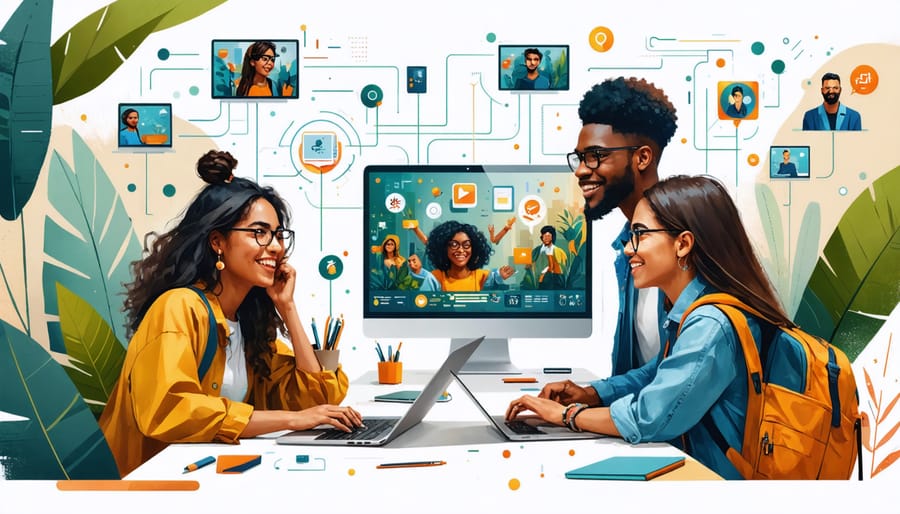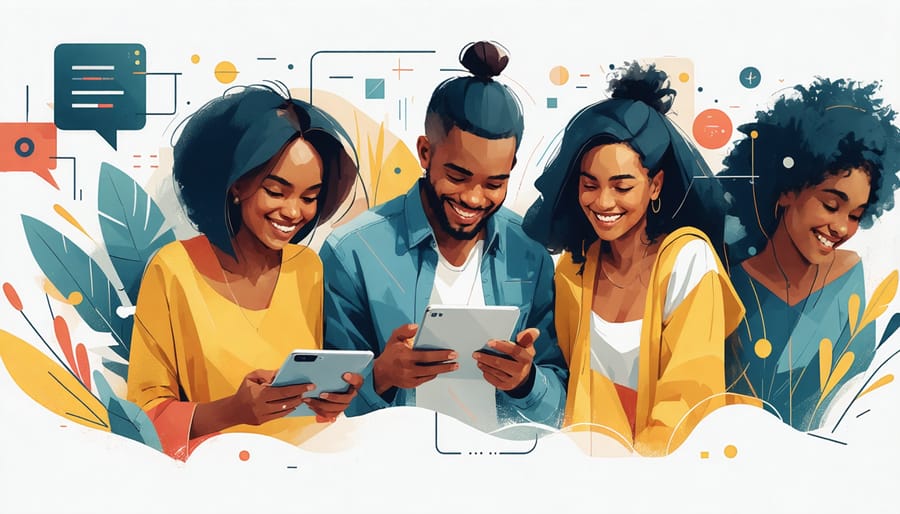
In today’s digital landscape, peer navigation has emerged as a crucial skill for building authentic connections and fostering meaningful relationships online. Whether you’re part of professional networks, social media communities, or digital support groups, understanding how to navigate peer relationships effectively can transform your online experience from merely transactional to deeply enriching.
Think of peer navigation as your personal compass in the digital world – it’s about more than just connecting; it’s about creating genuine bonds while maintaining healthy boundaries. As someone who’s spent years building online communities, I’ve discovered that successful peer navigation requires a delicate balance of authenticity, empathy, and clear communication.
The beauty of peer navigation lies in its power to bridge geographical gaps and bring together like-minded individuals who might never have connected otherwise. It’s about finding your tribe in the digital space while staying true to yourself and supporting others on their journey. Whether you’re looking to expand your professional network, find emotional support, or simply connect with others who share your interests, mastering peer navigation skills can open doors to meaningful relationships that transcend the digital divide.
In this guide, we’ll explore practical strategies for navigating online peer relationships with confidence, authenticity, and purpose.

Building Authentic Digital Connections
Finding Your Digital Tribe
Finding your digital tribe isn’t just about following trending hashtags or joining the biggest online communities. It’s about discovering spaces where you feel truly understood and welcomed. I remember spending months floating between various online groups before finding my perfect fit – a community of fellow creative entrepreneurs who shared my passion for sustainable living.
Start by identifying your core interests and values. Are you passionate about mindful parenting, sustainable fashion, or perhaps digital entrepreneurship? Use these as compass points to guide your search. Look for active communities on platforms that align with your communication style – whether that’s the visual inspiration of Instagram, the professional networking of LinkedIn, or the in-depth discussions on Reddit.
Pay attention to the energy and interaction patterns within these spaces. Does the conversation feel authentic? Are members supportive of each other? The best digital tribes often have clear community guidelines, engaged moderators, and regular meaningful interactions between members.
Don’t be afraid to test the waters before diving in. Observe discussions, participate in small ways, and gradually increase your engagement as you feel more comfortable. Remember, it’s perfectly okay to be part of multiple communities or to leave ones that no longer serve you.
Consider starting small by joining focused subgroups or participating in specific events within larger communities. This can help you build more meaningful connections while avoiding the overwhelm of massive online spaces.
Moving Beyond Surface-Level Interactions
Moving beyond “likes” and surface-level comments is essential for building genuine online friendships. I remember when I first joined an online book club – simply saying “great post!” wasn’t enough to create real connections. Instead, I started sharing personal reactions to specific plot points and relating them to my own experiences, which sparked meaningful conversations.
To deepen your online friendships, focus on asking thoughtful questions that invite reflection and storytelling. Rather than responding with a quick emoji, try sharing what resonated with you about someone’s post and why. For example, if a peer shares about a career challenge, acknowledge their feelings and maybe share a similar experience you’ve navigated.
Create opportunities for deeper discussion by being vulnerable first. Share your own challenges, celebrations, and learning moments – this often encourages others to open up too. Remember to follow up on previous conversations: “How did that presentation go?” or “Did you try that recipe you mentioned?”
Private messages can also help strengthen bonds. When something reminds you of a conversation you had with an online friend, send them a quick note. These spontaneous check-ins show you’re genuinely invested in the friendship beyond public interactions.
Most importantly, be consistent and authentic in your engagement. Real friendships, whether online or offline, thrive on regular, meaningful communication and genuine interest in each other’s lives.
Setting Healthy Digital Boundaries
The Art of Digital Self-Care
In our hyper-connected world, maintaining digital wellness isn’t just a luxury—it’s essential. As someone who’s navigated both the highs and lows of online relationships, I’ve learned that building digital emotional intelligence starts with mindful self-care practices.
First, establish clear boundaries around your online time. Try the 20-minute rule: set aside specific periods for meaningful engagement rather than endless scrolling. I’ve found that scheduling these intentional connection times helps me stay present both online and offline.
Create designated tech-free zones in your home and life. My personal favorite is the “sunset switch-off”—powering down devices an hour before bedtime to allow my mind to truly unwind. This simple practice has transformed my sleep quality and morning energy levels.
Listen to your emotional responses during online interactions. If certain conversations or communities leave you feeling drained rather than uplifted, it’s okay to step back. Consider maintaining a digital wellness journal to track how different online activities impact your mood and energy levels.
Remember to regularly check in with yourself about your digital relationships. Are they nurturing your growth? Do they align with your values? Just as you would tend to a garden, sometimes you need to prune your digital connections to allow the most meaningful ones to flourish.
Practice the art of mindful posting—pause before sharing and ask yourself: Is this authentic? Does it serve my well-being and that of my community? This thoughtful approach helps create more meaningful online connections while preserving your emotional energy.

Managing Online Energy and Time
Just like managing your energy in real-life friendships, creating sustainable online connections requires thoughtful boundaries and intentional practices. I’ve learned that setting specific “digital friendship hours” helps maintain a healthy balance between being present for others and preserving my own energy.
Consider designating certain times of the day for engaging with online friends, whether it’s responding to messages, commenting on posts, or participating in virtual gatherings. This structured approach prevents the exhaustion that comes from feeling constantly “on” while ensuring you remain reliably present for your digital peers.
Another game-changer has been implementing what I call the “quality over quantity” rule. Instead of trying to keep up with dozens of surface-level interactions, focus on nurturing a manageable number of meaningful online friendships. This might mean having deeper conversations with fewer people or participating more actively in select online communities rather than spreading yourself thin across many.
Don’t forget to regularly assess your digital energy levels. If you’re feeling drained, it’s perfectly okay to communicate your needs for space or establish temporary boundaries. Many of my closest online friends and I have a mutual understanding that sometimes we need to step back and recharge, and this honesty has actually strengthened our connections.
Remember, sustainable online friendships thrive on authenticity and respect for both parties’ time and energy. By setting clear expectations and honoring your limits, you create space for more meaningful and lasting digital connections.
Navigating Online Community Dynamics
Finding Your Voice Online
In today’s digital world, finding your authentic voice while navigating digital content authentically can feel like walking a tightrope. But here’s the truth: your unique perspective matters, and there’s a way to share it while respecting the communities you’re part of.
Start by observing the culture of your chosen online spaces. Just as you wouldn’t walk into a friend’s house without understanding their household rules, take time to understand the unwritten norms of digital communities. Notice how others communicate, what topics resonate, and how conflicts are resolved.
Remember, authenticity doesn’t mean sharing everything. Think of it as hosting a dinner party – you choose which stories to tell based on your audience while staying true to yourself. Share your experiences thoughtfully, focusing on what adds value to the conversation.
When expressing opinions, especially on sensitive topics, lead with empathy. Frame your thoughts as personal perspectives rather than absolute truths. Something as simple as “In my experience…” or “I’ve found that…” can make your voice more approachable while leaving room for different viewpoints.
Don’t be afraid to evolve your online voice over time. Like any relationship, your connection with digital communities will grow and change. The key is maintaining your core values while adapting your communication style to foster meaningful connections.
Handling Digital Disagreements
Even the closest online friendships can hit bumpy patches, but how we handle these moments makes all the difference. Just like in-person relationships, digital disagreements require patience, understanding, and a thoughtful approach. The key is implementing effective online communication strategies that preserve the friendship while addressing concerns.
When tensions arise, take a step back before responding. The instantaneous nature of online communication can sometimes lead to hasty reactions we later regret. Instead, draft your response and let it sit for an hour or two. This cooling-off period helps ensure your words come from a place of understanding rather than emotion.
Remember that text-based communication lacks the nuance of face-to-face interaction. What might read as hostile could simply be a friend having a rough day. Try asking clarifying questions instead of making assumptions. Something as simple as “I want to make sure I understood correctly – did you mean…” can prevent unnecessary conflict.
If a disagreement escalates, suggest moving the conversation to a video call where tone and body language can help bridge communication gaps. Sometimes, seeing a friendly face can instantly diffuse tension and remind both parties of the friendship’s value.
When resolving conflicts, focus on specific behaviors rather than character judgments, and always approach the situation with empathy and a willingness to understand different perspectives. After all, maintaining meaningful online friendships is worth the effort of working through occasional misunderstandings.

Supporting Others Online
Being a supportive presence online is about more than just clicking ‘like’ or dropping a quick emoji comment. It’s about showing up consistently and authentically for others in digital spaces. I’ve learned that genuine support often means actively listening to what others share, even when it’s through a screen.
Start by engaging meaningfully with others’ content – leave thoughtful comments that show you’ve really read and considered what they’re saying. When someone in your online community shares a challenge or celebration, take a moment to respond with genuine care and attention. Think of it as creating digital coffee dates where you’re fully present for the conversation.
Remember that timing matters too. Sometimes, being there means checking in with a private message when you notice someone hasn’t posted in a while or seems to be going through a tough time. Share relevant resources or articles that might help them, but always ask if they’re open to advice first.
Creating a supportive online environment also means standing up against negativity while maintaining grace. If you see someone facing harsh comments or criticism, offer encouragement privately or publicly, depending on what feels appropriate. Just like in-person friendships, online support is about consistency, authenticity, and showing up when it matters most.
Consider keeping a small circle of online friends you check in with regularly rather than trying to support everyone superficially. This approach helps build deeper, more meaningful connections in the digital space.
As we navigate the ever-evolving landscape of digital relationships, remember that authentic connections are possible with mindful engagement and clear boundaries. I’ve learned through my own journey that maintaining healthy online peer relationships isn’t about being everywhere at once or saying yes to every virtual coffee date – it’s about creating meaningful interactions that enrich our lives while respecting our time and energy.
Focus on quality over quantity in your digital connections. Choose platforms and communities that align with your values and interests, and don’t feel pressured to maintain a presence everywhere. Set aside dedicated time for meaningful interactions, whether it’s commenting thoughtfully on a friend’s post or participating in online group discussions.
Remember to regularly check in with yourself about your digital relationships. Are they energizing or draining? Are you maintaining a healthy balance between online and offline connections? Don’t hesitate to adjust your boundaries or step back when needed – true friends will understand and respect your needs.
Most importantly, bring your authentic self to your online interactions. Share your experiences, celebrate others’ successes, and be present in your digital communities. By approaching peer navigation with intention and authenticity, you’ll create lasting connections that enhance your life while maintaining your well-being in our interconnected world.
Together, we can build supportive, genuine digital relationships that stand the test of time and technology.


